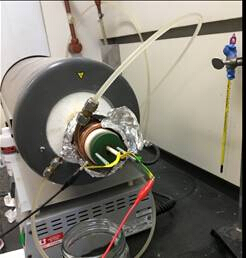电化学阻抗光谱
Overview
资料来源:卡拉·英格拉哈姆、贾里德·麦库琴和泰勒·斯帕克斯,犹他大学材料科学与工程系,盐湖城,犹他州
电阻是电路元件抵抗电流的能力。电阻由欧姆定律定义:
 (公式 1)
(公式 1)
电压
 和电流在哪里。欧姆定律可用于确定理想电阻器的电阻。然而,许多电路元件更为复杂,不能单靠电阻来描述。例如,如果使用交流电 (AC),电阻率通常取决于交流信号的频率。电阻抗不是单独使用电阻,而是对电路元件抵抗电流的能力的更准确和可概括的测量。
和电流在哪里。欧姆定律可用于确定理想电阻器的电阻。然而,许多电路元件更为复杂,不能单靠电阻来描述。例如,如果使用交流电 (AC),电阻率通常取决于交流信号的频率。电阻抗不是单独使用电阻,而是对电路元件抵抗电流的能力的更准确和可概括的测量。
最常见的是,电阻抗测量的目标是将样品的总电阻抗递解到不同机制(如电阻、电容或感应)的贡献中。
Procedure
- 获取测试模块,并通过两个电极将其连接到 EIS 仪器。如图3所示的测试模块提供了可用于对简单、已知的电路建模的数据。它可用于确认导线正确连接到机器,并且所有机械部件都正常工作。

图3:测试模块。
- 要开始流过样品的电流,打开计算机上的 Zplot 软件。从这个软件,你可以设置你的样品的参数,根据需要。在测试模块上运行测试时,在"极化"下,将直流电位设置为 0,将交流振幅设置为 10 mV,并确保下拉箭头显示"与开路"。在"频率扫描"部分下,将初始频率设置为 1x10_6 Hz,将最终频率设置为 100 Hz,将间隔设置为 10。还要选择"对数"和"步骤/十年"。然后按"好"开始新的阅读。
- 打开 Zview 软件以查看结果。选择要绘制的 z' 和 z''。结
Results
Application and Summary
Tags
跳至...
此集合中的视频:

Now Playing
电化学阻抗光谱
Materials Engineering
23.4K Views

光学材料学第1部分:样品制备
Materials Engineering
15.5K Views

光学材料学第2部分:图像分析
Materials Engineering
11.1K Views

X射线光电子光谱
Materials Engineering
21.8K Views

X 射线衍射
Materials Engineering
89.4K Views

聚焦 Ion 光束
Materials Engineering
8.9K Views

定向凝固和相位稳定
Materials Engineering
6.6K Views

差分扫描热量测定
Materials Engineering
38.3K Views

热衍率与激光闪光方法
Materials Engineering
13.3K Views

薄膜电镀
Materials Engineering
20.2K Views

通过测热分析的热膨胀分析
Materials Engineering
15.9K Views

陶瓷基质复合材料及其弯曲特性
Materials Engineering
8.3K Views

纳米晶体合金和纳米颗粒尺寸稳定性
Materials Engineering
5.2K Views

水凝胶合成
Materials Engineering
23.8K Views
版权所属 © 2025 MyJoVE 公司版权所有,本公司不涉及任何医疗业务和医疗服务。


